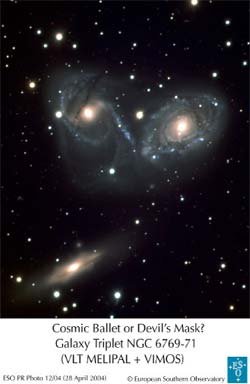Cosmic Ballet or Devil’s Mask?

Very Large Telescope Witnesses Close Interaction in Galaxy Family
Stars like our Sun are members of galaxies, and most galaxies are themselves members of clusters of galaxies. In these, they move around among each other in a mostly slow and graceful ballet. But every now and then, two or more of the members may get too close for comfort – the movements become hectic, sometimes indeed dramatic, as when galaxies end up colliding.
ESO PR Photo 12/04 shows an example of such a cosmic tango. This is the superb triple system NGC 6769-71, located in the southern Pavo constellation (the Peacock) at a distance of 190 million light-years.
This composite image was obtained on April 1, 2004, the day of the Fifth Anniversary of ESO’s Very Large Telescope (VLT). It was taken in the imaging mode of the VIsible Multi-Object Spectrograph (VIMOS) on Melipal, one of the four 8.2-m Unit Telescopes of the VLT at the Paranal Observatory (Chile). The two upper galaxies, NGC 6769 (upper right) and NGC 6770 (upper left), are of equal brightness and size, while NGC 6771 (below) is about half as bright and slightly smaller. All three galaxies possess a central bulge of similar brightness. They consist of elderly, reddish stars and that of NGC 6771 is remarkable for its “boxy” shape, a rare occurrence among galaxies.
Gravitational interaction in a small galaxy group
NGC 6769 is a spiral galaxy with very tightly wound spiral arms, while NGC 6770 has two major spiral arms, one of which is rather straight and points towards the outer disc of NGC 6769. NGC 6770 is also peculiar in that it presents two comparatively straight dark lanes and a fainter arc that curves towards the third galaxy, NGC 6771 (below). It is also obvious from this new VLT photo that stars and gas have been stripped off NGC 6769 and NGC 6770, starting to form a common envelope around them, in the shape of a Devil’s Mask. There is also a weak hint of a tenuous bridge between NGC 6769 and NGC 6771. All of these features testify to strong gravitational interaction between the three galaxies. The warped appearance of the dust lane in NGC 6771 might also be interpreted as more evidence of interactions.
Moreover, NGC 6769 and NGC 6770 are receding from us at a similar velocity of about 3800 km/s – a redshift just over 0.01 – while that of NGC 6771 is slightly larger, 4200 km/s.
A stellar baby-boom
As dramatic and destructive as this may seem, such an event is also an enrichment, a true baby-star boom. As the Phoenix reborn from its ashes, a cosmic catastrophe like this one normally results in the formation of many new stars. This is obvious from the blueish nature of the spiral arms in NGC 6769 and NGC 6770 and the presence of many sites of star forming regions.
Similarly, the spiral arms of the well-known Whirlpool galaxy (Messier 51) may have been produced by a close encounter with a second galaxy that is now located at the end of one of the spiral arms; the same may be true for the beautiful southern galaxy NGC 1232 depicted in another VLT photo (PR Photo 37d/98).
Nearer to us, a stream of hydrogen gas, similar to the one seen in ESO PR Photo 12/04, connects our Galaxy with the LMC, a relict of dramatic events in the history of our home Galaxy. And the stormy time is not yet over: now the Andromeda Galaxy, another of the Milky Way neighbours in the Local Group of Galaxies, is approaching us. Still at a distance of over 2 million light-years, calculations predict that it will collide with our galaxy in about 6,000 million years!
Media Contact
More Information:
http://www.eso.org/outreach/press-rel/pr-2004/phot-12-04.htmlAll latest news from the category: Physics and Astronomy
This area deals with the fundamental laws and building blocks of nature and how they interact, the properties and the behavior of matter, and research into space and time and their structures.
innovations-report provides in-depth reports and articles on subjects such as astrophysics, laser technologies, nuclear, quantum, particle and solid-state physics, nanotechnologies, planetary research and findings (Mars, Venus) and developments related to the Hubble Telescope.
Newest articles

Magnetic Memory Unlocked with Energy-Efficient MRAM
Researchers from Osaka University introduced an innovative technology to lower power consumption for modern memory devices. Stepping up the Memory Game: Overcoming the Limitations of Traditional RAM Osaka, Japan –…

Next-Level System Security: Smarter Access Control for Organizations
Cutting-Edge Framework for Enhancing System Security Researchers at the University of Electro-Communications have developed a groundbreaking framework for improving system security by analyzing business process logs. This framework focuses on…

How Microbial Life Shapes Lime Formation in the Deep Ocean
Microorganisms are everywhere and have been influencing the Earth’s environment for over 3.5 billion years. Researchers from Germany, Austria and Taiwan have now deciphered the role they play in the…



